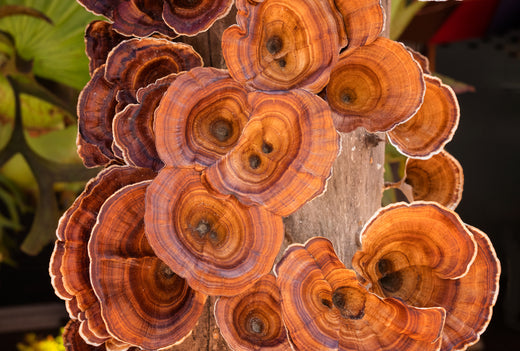Calming Reishi Mushrooms: Their History and How to Take Reishi

Share
Reishi mushroom, known as the ‘mushroom of immortality’ in ancient Chinese texts, is reported to have many healing properties. It’s also one of the most studied mushrooms to date.
The scientific name of Reishi is Ganoderma lucidum. The Latin word lucidus means “shiny” or “brilliant”, which refers to its fruiting body having a distinctive glossy or varnished finish with a striking reddish-brown colour.
It’s a polypore shelf mushroom, and it doesn’t have gills on its underside. It releases its spores via fine pores and grows on both dead and living trees.
In this post, we’re going to take a closer look at calming Reishi mushrooms and how to take Reishi.
History of Calming Reishi Mushrooms
The first records of mushroom cultivation for culinary and medicinal purposes date from thousands of years ago in East Asia.
The 5th century alchemist, Tao Hongjing, defined Reishi as the “supreme protector,” and advised that it could protect us on many levels– physically, mentally, immunologically, and spiritually.
Due to its history of healing and improving the lives of prolific emperors, Reishi was named the mushroom of immortality.
The Japanese term Reishi derives from the Chinese word Ling Zhi. In China, Ling Zhi is known as a symbol of good health and fortune, and it’s regarded as the “herb of spiritual potency”.(1) It’s also been defined as a symbol of success, well-being, divine power, and longevity.
Reishi has been depicted in East Asian painted murals, sculptured into pillars, doors, and archways, and has been woven into clothes. Dried specimens even feature in museums as “world treasures”.
Reishi is also known as Shen tonic. Within Traditional Chinese Medicine (TCM), Shen translates to our spirit and/or our “higher consciousness," representing the divinity within all of us and the source of who we truly are. According to TCM, if we want to lead a long and peaceful life, we must nourish and maintain Shen.
It’s no surprise that today researchers are keen to explore the health-giving and calming properties of Reishi, as well as how to take Reishi.
Polysaccharades
Studies have shown Reishi contains over 400 different biologically active constituents. (2) Some of the most important therapeutic components within Reishi are polysaccharides and triterpenoids.
Reishi contains over 100 different polysaccharide compounds. Polysaccharides are complex long-chain sugar molecules (healthy sugars) that have been shown to enhance and activate the immune system. A recent study suggests polysaccharides isolated from Reishi induce a self-triggered immune response.
Triterpenes
Triterpenes are one of the primary beneficial compounds in Reishi alongside beta-glucans (and account for its bitter taste).
Sleep - The Key to a Long and Healthy Life
Stanford professor and neuroscientist Andrew Huberman describes sleep as “the foundation of our mental and physical health and performance in all endeavours” and as the “best nootropic, stress reliever, immune booster, and emotional stabiliser.”
Although sleep deprivation has become an epidemic, there are a number of ways we can improve the quality of our sleep, as we discuss in our blog on how to naturally master your sleep.
How to Take Reishi
Reishi has an earthy, bitter taste due to its triterpenes.
When thinking about how to take Reishi, the best ways are in tea, capsules, or powder form added to shakes or juices. We love to experiment, and this relaxing smoothie bowl is one of our absolute favourites.
Our Reishi mushroom powder is perfect for this.
REFERENCES
- Wachtel-Galor, S., Yuen, J., Buswell, J,A., and Benzie, Iris F, F. (2011). Ganoderma lucidum (Lingzhi or Reishi): A Medicinal Mushroom. In: Benzie IFF, Wachtel-Galor S, (ed.) Herbal Medicine: Biomolecular and Clinical Aspects. 2nd edition. Boca Raton (FL): CRC Press/Taylor & Francis; 2011. Chapter 9.Available from: https://www.ncbi.nlm.nih.gov/books/NBK92757/
- Ahmad, M, F. (2018).Ganoderma lucidum: Persuasive biologically active constituents and their health endorsement, Biomedicine & Pharmacotherapy, 107, pp. 507-519. Available from: https://doi.org/10.1016/j.biopha.2018.08.036.






